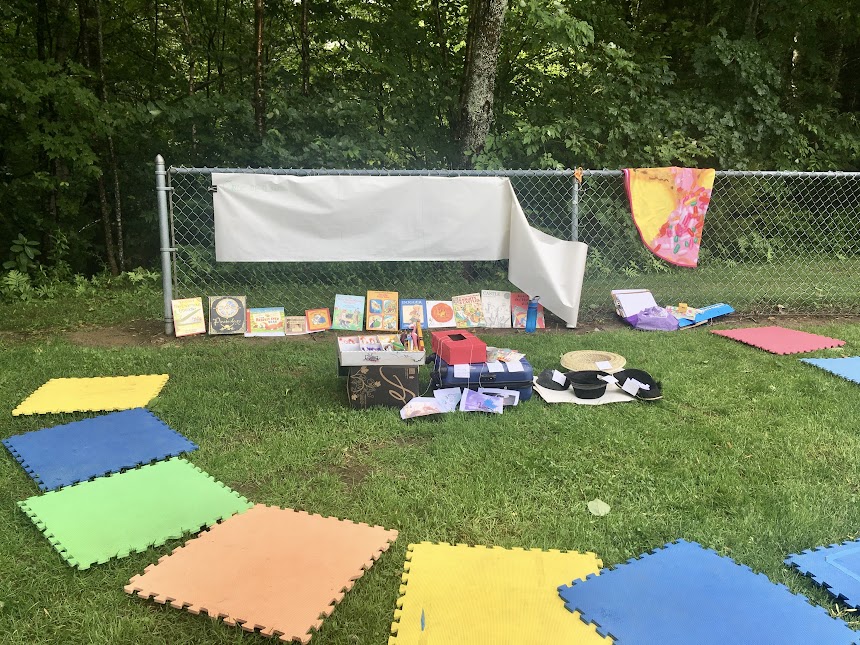This Week’s Bit of String: Summer camp workshops
It’s humid in New Hampshire, and the grass is wet from last night’s thunderstorms. Twelve kids sit around me on coloured interlocking foam mats. I have armed them with clipboards, paper, pencils in all different shapes including dragons and flamingos and drumsticks, stickers, and mystery keys.
A trio of boys are doing Mad Libs together, mainly supplying each gap with some form of “cat” or “farting.” They like cats, and of course farts are the pinnacle of wit at this stage. The group’s counsellor is lying on his back, clipboard in the air, blissfully writing a poem. Other kids are writing stories about where their key might unlock, or comics about bunnies or bananamen.
One of the mats has a little slug curled on a corner. I remark on it, and an 8-year-old boy approaches me earnestly.

“You know snails? If you find one, and it’s deep inside the shell and wants to stay hiding, you can hum to it. Then it will poke out.”
“That’s interesting, how did you learn that? Did you try it yourself?”
He nods. I’m picturing him crouching on the damp ground, snailshell in his palm, leaning down to hum and watching in wonder as a squidgy creature emerges, antennae first.
Permission to Imagine
I haven’t done much like this before. Working in secondary British education, creative writing is not a curriculum priority at all. When I had an opportunity to work with the kids, ages 6-11, at the day camp where my son works, I didn’t set a rigid outcome for us but came up with a lot of different activities we might try, independently or all together, to have a little romp through our imaginations.
I got some wonderful suggestions and encouragement from other writers on Twitter. One of the most fruitful was getting vintage-style keys, which you can buy in packs as party favours. Kids pick one up, examine it, and write (or dictate, or draw) what the key might lead to.

The campers loved the keys, and they knew exactly how to put on little pleading faces to take one home. I gave away quite a few. There were stories about pirates who got scared by the key and threw it into lava, stories about locked doors guarded by snakes, and even one where it turned out the key went to a porta-potty.
I revelled in this variety. I’d used Mad Libs as a starter, having the kids volunteer adjectives and nouns and verbs as required to fill in the story’s blanks, and then reading the funny results out so they knew right away they were allowed to be silly and break rules. One group liked that so much, several of them wrote their own Mad Libs—quite good little stories where they left words out, brought them to me, and I supplied the most random ones I could think of.
Your Words Change Things
The other reason I wanted to start with Mad Libs was because I wanted to let them know, a story doesn’t have to ALL come from you. In fact, I would argue we often borrow certain elements. But once we put our own point of view, our own language and especially follow our own what-if questions, the story becomes ours.
I had brought four hats: three were for the adjectives, nouns, and verbs for Mad Libs in case some groups were too young for parts of speech or wanted to take suggestions. The other had what-ifs in case anyone wanted to use an idea for a story. What if a shark appeared in the lake across the street? What if your teacher was a Russian spy? What if you had a million dollars? What if Cinderella’s fairy godmother had poor fashion sense?

Asking what if changes a path, using a randomly selected noun will change a sentence… our words change things. In one of my younger groups, we did a group story. This was also my last group, and I’d recognised that kids, especially older ones, didn’t want to use suggestions or try picking words out of a hat, because they felt so compelled to ensure their work was their own. But sometimes they got stuck. So with this group, I offered hats right away to choose words for Mad Libs, and they liked it a lot. Everyone wanted to pick a word from a straw hat, or a feathered pirate one, or a beret.
When we’d finished the Mad Lib, we did a couple of group stories, penning them on the paper I’d rigged up across the chainlink fence. We’d pick a noun from a hat, like spaceship, then describe that and give it some detail as we chose. Next we drew another noun to see what our noun would interact with, then a couple of verbs for extra suggestions what they might do. Thus we ended up with a farmyard on Mercury, with big fans to keep cool and three-eyed alien animals that said Oom instead of Moo, discovered by a nice family that visits space every first Sunday of the month.
I so enjoyed meeting the kids and hearing their ideas, but I’d also had fun while working hard to prepare. It made me happy thinking of exciting words and questions to put in the hats. What if I used them in my own writing? What if we got a little crazier with our ideas?
It’s like holding up a snail shell, wondering how we can see and befriend the creature inside. Unless we try humming to it, we won’t know what works.